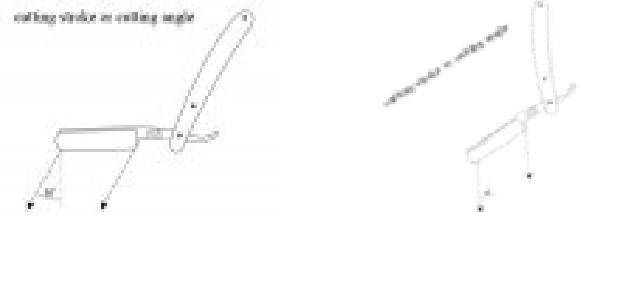Results 1 to 10 of 23
Thread: Scything questions
Hybrid View
-
06-21-2009, 06:00 PM #1---

- Join Date
- Jan 2009
- Posts
- 1,230
Thanked: 278
Unfortunately there are two different methods that are called scything - the one you describe, and this one:
http://straightrazorpalace.com/shavi...tml#post313829

The image on the left is what most of us (and the old barber texts) mean by scything. On the right you see the guillotine method.
And if you look closely you will see they are the same diagram! The two methods are one and the same. However, I believe it is safer to think of it as a guillotine action, you only need to think about movement in one dimension and you are less likely to mess up as a result of thinking about a sideways motion.
-
06-21-2009, 06:31 PM #2

a safe way to start learning is to lead with the heel
it is closest to your hand and you have lots of control
I have 2 or more inches of lateral motion on every pass, very similar to the 45 used when honing
in other words, the toe ends up where the heel started
-
06-21-2009, 09:28 PM #3Antipodean

- Join Date
- May 2009
- Location
- Dunedin, New Zealand
- Posts
- 522
Thanked: 137
Thanks Joe, that was exactly what I was after - just wanted to know if I should be learning this technique from the get-go or holding off on it.
-
06-23-2009, 07:53 PM #4Senior Member

- Join Date
- Feb 2007
- Location
- Chicagoland
- Posts
- 844
Thanked: 155
-
06-24-2009, 02:57 AM #5---

- Join Date
- Jan 2009
- Posts
- 1,230
Thanked: 278
Precisely. It is an identical technique being used in a different direction.
Those two diagrams are the same one. Only the viewpoint has changed.
The scythe analogy has been used to describe a cutting motion with a slicing action at least as far back as Perret's "La Pogonotomie" (1770)
If you watch a video of scything, then sure, the handle is being rotated, but the key point is that the blade slices through the grass. Originally Posted by Perret's "La Pogonotomie"
Originally Posted by Perret's "La Pogonotomie"
Maybe it's a poor choice of word because it can be interpreted two ways, but I'm pretty sure that the traditional interpretation was a diagonal stroke, not a rotational one.
Perfect close-up example of how a scythe cuts here, you'll have to click the box twice, as it won't embed. The sharp edge of the blade is facing the user:
http://www.youtube.com/watch?v=KciDA...eature=relatedLast edited by Rajagra; 06-24-2009 at 03:30 AM. Reason: Added video link.
The Following User Says Thank You to Rajagra For This Useful Post:
warpigs421 (06-24-2009)
06-24-2009, 04:59 PM
#6
Of course we should not forget that razors in those days (late 17 hundreds) are imcomparable to the razors of these days. I remember a review on a Civil War era razor on SRP. Reviewer commented that the steel was not so hard and it took more effort to cut hairs. I find that last century's razors don't need a slicing action. But that's me.Originally Posted by Perret's "La Pogonotomie"
A razor's edge needs teeth, because its action is not to cut, nor to slash or hack, but to scythe.
Plus ça change, plus c'est la même chose. Jean-Baptiste Alphonse Karr.
06-29-2009, 02:14 PM
#7
You might find it useful to try these strokes using a DE razor for a while to get used to them before trying them with a straight.But man alive they don't half get rid of the most hard to shift areas.


 LinkBack URL
LinkBack URL About LinkBacks
About LinkBacks







 Reply With Quote
Reply With Quote
